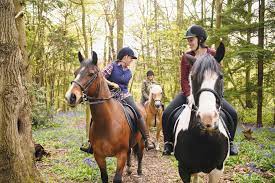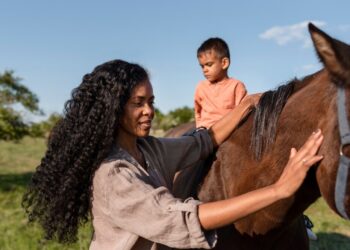Horse riding is a rewarding and exhilarating activity, but it also comes with certain risks. From falls and injuries to accidents and emergencies, there are many potential hazards associated with horse riding. However, by taking the necessary precautions and following proper safety guidelines, it is possible to minimize these risks and enjoy horse riding safely. In this article, we will explore some of the common risks associated with horse riding and how to minimize them.
Falls and Injuries
One of the most common risks associated with horse riding is falls and injuries. Whether you are a beginner or an experienced rider, falls can happen for a variety of reasons, including spooking, loss of balance, or equipment failure. To minimize the risk of falls and injuries, it is important to wear proper safety gear, including a well-fitted helmet, boots with a heel, and protective clothing. Additionally, it is important to ride with a qualified instructor or experienced rider who can provide guidance and support, as well as to choose a horse that is well-trained and suitable for your skill level.
Horse Behavior
Another common risk associated with horse riding is unpredictable or dangerous horse behavior. Horses are large and powerful animals, and their behavior can be influenced by a variety of factors, including their environment, health, and mood. To minimize the risk of horse-related accidents, it is important to work with a qualified instructor or trainer who can help you to understand horse behavior and communication. Additionally, it is important to always handle horses with care and respect, and to avoid behaviors that could startle or upset them.
Equipment Failure
Equipment failure is another potential risk associated with horse riding. This can include problems with the saddle, bridle, or other equipment, which can cause accidents or injuries. To minimize the risk of equipment failure, it is important to inspect and maintain your equipment regularly, and to replace any worn or damaged parts as needed. Additionally, it is important to choose high-quality equipment that is appropriate for your needs and skill level.

Environmental Hazards
Environmental hazards, such as uneven terrain, obstacles, and inclement weather, can also pose a risk to horse riders. To minimize the risk of environmental hazards, it is important to ride in safe and appropriate locations, and to avoid riding in extreme weather conditions. Additionally, it is important to be aware of your surroundings and to take appropriate precautions when riding in unfamiliar or potentially hazardous areas.
Emergencies
Finally, emergencies, such as horse-related injuries or accidents, can also pose a risk to horse riders. To minimize the risk of emergencies, it is important to ride with a qualified instructor or experienced rider who can provide first aid and emergency care if needed. Additionally, it is important to always carry a first aid kit and emergency contact information with you when riding, and to be familiar with basic first aid procedures.
Horse riding can be a rewarding and enjoyable activity, but it also comes with certain risks. By taking the necessary precautions and following proper safety guidelines, it is possible to minimize these risks and enjoy horse riding safely. Remember to wear proper safety gear, ride with a qualified instructor or experienced rider, handle horses with care and respect, inspect and maintain your equipment regularly, ride in safe and appropriate locations, carry a first aid kit and emergency contact information, and be prepared for emergencies. With these precautions in mind, you can enjoy horse riding safely and with confidence.

It is also important to note that proper training and education are key to minimizing the risks associated with horse riding. Before getting on a horse, it is important to receive proper instruction and training from a qualified instructor or trainer. This can help to ensure that you have the necessary skills and knowledge to ride safely and confidently. Additionally, it is important to continue your education and training on an ongoing basis, as there is always more to learn about horse riding and horse behavior.
Furthermore, it is important to recognize that horse riding safety is not just about minimizing risks, but also about promoting a culture of safety and respect. This means respecting the horses and other riders, following established safety guidelines, and being aware of your surroundings and the potential hazards that may arise. By promoting a culture of safety and respect, we can create a safer and more enjoyable environment for everyone involved in horse riding.
It is also worth noting that horse riding safety is not just important for riders, but also for horses. Horses are living beings that require proper care and attention, and it is our responsibility as riders to ensure that they are treated with respect and compassion. This includes providing proper nutrition, exercise, and veterinary care, as well as being aware of their physical and emotional needs.
In conclusion,
Horse riding safety is a crucial aspect of enjoying this rewarding and exhilarating activity. By taking the necessary precautions and following proper safety guidelines, we can minimize the risks associated with horse riding and promote a culture of safety and respect. Remember to receive proper training and education, wear proper safety gear, ride with a qualified instructor or experienced rider, handle horses with care and respect, inspect and maintain your equipment regularly, ride in safe and appropriate locations, carry a first aid kit and emergency contact information, and be prepared for emergencies. With these precautions in mind, we can enjoy horse riding safely and with confidence, while also promoting the well-being of the horses and other riders involved.
It is important to note that horse riding safety can also vary depending on the type of horse riding activity. For example, jumping and cross-country riding may involve different risks and safety considerations than trail riding or dressage. It is important to be aware of the specific risks and safety guidelines associated with your chosen horse riding activity, and to take appropriate precautions to ensure your safety and the safety of those around you.
Finally, it is important to recognize that accidents and injuries can still occur, despite our best efforts to minimize risks and promote safety. In the event of an accident or injury, it is important to remain calm and seek immediate medical attention if needed. Additionally, it is important to report any accidents or injuries to the appropriate authorities or organizations, as this can help to prevent future accidents and improve safety for all involved.













